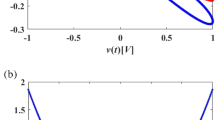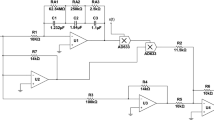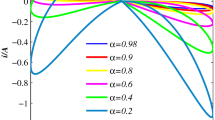Abstract
In this paper, a novel active generalized fractional-order memristor is constructed by using a memristor diode bridge in parallel with a negative resistance. Combined with fractional calculus theory, the fractional-order model of the memristor is constructed by using predictive correction method. The model is connected in parallel with a capacitor to form a second-order nonlinear filter and coupled with an RC bridge oscillator to form a chaotic circuit. The fractional-order memristor model and the chaotic circuit it forms are novel. The mathematical model of the fractional-order memristor chaotic system is established, and its dynamic behavior is analyzed by theoretical calculation and numerical simulation. Dynamic characteristics of the system are verified by time series, phase diagram, bifurcation diagram and Lyapunov exponent spectrum, and the results of numerical simulation and analog outputs of electronic circuit are the same as expected. Finally, the fractional-order memristor chaotic circuit is realized by FPGA hardware circuit experiment, and its phase diagram is observed by oscilloscope to be consistent with numerical simulation and circuit simulation, which verifies the effectiveness of theoretical analysis.





















Similar content being viewed by others
Data Availability
All data generated or analyzed during this study are included in this article [and its supplementary information files].
References
N.H. Alombah, H. Fotsin, K. Romanic, Coexistence of multiple attractors, metastable chaos and bursting oscillations in a multiscroll memristive chaotic circuit. Int. J. Bifurc. Chaos 27(05), 1750067 (2017)
A. Atangana, J. Gómez-Aguilar, Decolonisation of fractional calculus rules: breaking commutativity and associativity to capture more natural phenomena. Eur. Phys. J. Plus 133(4), 1–22 (2018)
A. Atangana, J. Gómez-Aguilar, Fractional derivatives with no-index law property: application to chaos and statistics. Chaos Solitons Fract. 114, 516–535 (2018)
D. Chen, C. Liu, C. Wu et al., A new fractional-order chaotic system and its synchronization with circuit simulation. Circuits Syst. Signal Process. 31(5), 1599–1613 (2012)
M. Chen, J. Qi, Q. Xu et al., Quasi-period, periodic bursting and bifurcations in memristor-based Fitzhugh–Nagumo circuit. AEU Int. J. Electron. Commun. 110(152), 840 (2019)
M. Chen, X. Ren, H.G. Wu et al., Periodically varied initial offset boosting behaviors in a memristive system with cosine memductance. Front. Inf. Technol. Electron. Eng. 20(12), 1706–1716 (2019)
W. Chunhua, L. Hairong, S. Jingru et al., Research progress on chaos, memory and neural network circuits based on memristor. J. Electron. Inf. Technol. 42(4), 795–810 (2020)
A. Coronel-Escamilla, J. Solís-Pérez, J. Gómez-Aguilar et al., Dynamics and synchronization of a fractional conformable neural network with power-law. Eur. Phys. J. Spec. Top., pp. 1–18 (2022)
M. Di Ventra, Y.V. Pershin, L.O. Chua, Circuit elements with memory: memristors, memcapacitors, and meminductors. Proc. IEEE 97(10), 1717–1724 (2009)
M. Fouda, A. Radwan, On the fractional-order memristor model. J. Fract. Calculus Appl. 4(1), 1–7 (2013)
M.E. Fouda, A.G. Radwan, Fractional-order memristor response under DC and periodic signals. Circuits Syst. Signal Process. 34(3), 961–970 (2015)
B. Guo, X. Pu, F. Huang, Fractional Partial Differential Equations and Their Numerical Solutions (World Scientific, Singapore, 2015)
W. Hu, D. Ding, Y. Zhang et al., Hopf bifurcation and chaos in a fractional order delayed memristor-based chaotic circuit system. Optik 130, 189–200 (2017)
M. Itoh, L.O. Chua, Memristor oscillators. Int. J. Bifurc. Chaos 18(11), 3183–3206 (2008)
P.D.K. Kuate, A.E.T. Tchendjeu, H. Fotsin, A modified rössler prototype-4 system based on chua’s diode nonlinearity: dynamics, multistability, multiscroll generation and fpga implementation. Chaos Solitons Fractals 140(110), 213 (2020)
J.F. Li, H. Jahanshahi, S. Kacar et al., On the variable-order fractional memristor oscillator: data security applications and synchronization using a type-2 fuzzy disturbance observer-based robust control. Chaos Solitons Fractals 145(110), 681 (2021)
J. Luo, H. Bao, M. Chen et al., Inductor-free multi-stable chua’s circuit constructed by improved pi-type memristor emulator and active sallen-key high-pass filter. Eur. Phys. J. Spec. Top. 228(10), 1983–1994 (2019)
J. Luo, H. Bao, M. Chen et al., Inductor-free multi-stable chua’s circuit constructed by improved pi-type memristor emulator and active sallen-key high-pass filter. Eur. Phys. J. Spec. Top. 228(10), 1983–1994 (2019)
X. Ma, J. Mou, J. Liu et al., A novel simple chaotic circuit based on memristor–memcapacitor. Nonlinear Dyn. 100(3), 2859–2876 (2020)
O. Martínez-Fuentes, J.J. Montesinos-García, J.F. Gómez-Aguilar, Generalized synchronization of commensurate fractional-order chaotic systems: applications in secure information transmission. Digit. Signal Process. 126(103), 494 (2022)
F. Meng, X. Zeng, Z. Wang, Impulsive anti-synchronization control for fractional-order chaotic circuit with memristor. Indian J. Phys. 93(9), 1187–1194 (2019)
L. Merah, A. Ali-Pacha, N.H. Said et al., Design and FPGA implementation of Lorenz chaotic system for information security issues. Appl. Math. Sci. 7(5), 237–246 (2013)
K.D. Park, The Analysis of Fractional Differential Equations. Lecturer Notes in Mathematics (2010)
P. Prakash, K. Rajagopal, I. Koyuncu et al., A novel simple 4-D hyperchaotic system with a saddle-point index-2 equilibrium point and multistability: design and FPGA-based applications. Circuits Syst. Signal Process. 39(9), 4259–4280 (2020)
K. Rajagopal, A. Karthikeyan, A.K. Srinivasan, Fpga implementation of novel fractional-order chaotic systems with two equilibriums and no equilibrium and its adaptive sliding mode synchronization. Nonlinear Dyn. 87(4), 2281–2304 (2017)
K. Rajagopal, A. Karthikeyan, A. Srinivasan, Dynamical analysis and FPGA implementation of a chaotic oscillator with fractional-order memristor components. Nonlinear Dyn. 91(3), 1491–1512 (2018)
K. Rajagopal, S.T. Kingni, A.J.M. Khalaf et al., Coexistence of attractors in a simple chaotic oscillator with fractional-order-memristor component: analysis, FPGA implementation, chaos control and synchronization. Eur. Phys. J. Spec. Top. 228(10), 2035–2051 (2019)
A.A. Rezk, A.H. Madian, A.G. Radwan et al., Reconfigurable chaotic pseudo random number generator based on FPGA. AEU Int. J. Electron. Commun. 98, 174–180 (2019)
J. Ruan, K. Sun, J. Mou et al., Fractional-order simplest memristor-based chaotic circuit with new derivative. Eur. Phys. J. Plus 133(1), 1–12 (2018)
M.E. Sahin, Z.G. Cam Taskiran, H. Guler et al., Application and modeling of a novel 4D memristive chaotic system for communication systems. Circuits Syst. Signal Process. 39(7), 3320–3349 (2020)
E.Y. Sar, I.B. Giresunlu, Fractional differential equations. Pramana-J. Phys. 87, 17 (2016)
L. Teng, H.H. Iu, X. Wang et al., Chaotic behavior in fractional-order memristor-based simplest chaotic circuit using fourth degree polynomial. Nonlinear Dyn. 77(1), 231–241 (2014)
V. Varshney, S. Sabarathinam, A. Prasad et al., Infinite number of hidden attractors in memristor-based autonomous Duffing oscillator. Int. J. Bifurc. Chaos 28(01), 1850013 (2018)
E. Viera-Martin, J. Gómez-Aguilar, J. Solís-Pérez et al., Anti-synchronization of a m-hopfield neural network with generalized hyperbolic tangent activation function. Eur. Phys. J. Spec. Top., pp. 1–14 (2022)
C. Wu, Q. Zhang, Z. Liu et al., Dynamic behaviors analysis of a novel fractional-order Chua’s memristive circuit. Mathematical Problems in Engineering (2021)
H. Wu, Y. Ye, B. Bao et al., Memristor initial boosting behaviors in a two-memristor-based hyperchaotic system. Chaos Solitons Fractals 121, 178–185 (2019)
W. Xie, C. Wang, H. Lin, A fractional-order multistable locally active memristor and its chaotic system with transient transition, state jump. Nonlinear Dyn. 104(4), 4523–4541 (2021)
P.Y. Xiong, H. Jahanshahi, R. Alcaraz et al., Spectral entropy analysis and synchronization of a multi-stable fractional-order chaotic system using a novel neural network-based chattering-free sliding mode technique. Chaos Solitons Fractals 144(110), 576 (2021)
B. Xu, G. Wang, H.H.C. Iu et al., A memristor-meminductor-based chaotic system with abundant dynamical behaviors. Nonlinear Dyn. 96(1), 765–788 (2019)
N. Yang, Y. Han, C. Wu et al., Dynamic analysis and fractional-order adaptive sliding mode control for a novel fractional-order ferroresonance system. Chin. Phys. B 26(8), 080503 (2017)
J. Ying, Y. Liang, G. Wang et al., Locally active memristor based oscillators: the dynamic route from period to chaos and hyperchaos. Chaos Interdiscip. J. Nonlinear Sci. 31(6), 063114 (2021)
Q. Yu, B. Bao, Q. Xu et al., Research on non-inductive chaotic circuit based on active generalized memristor. J. Phys. 64(18), 180501 (2015)
Y. Yu, H. Bao, M. Shi et al., Complex dynamical behaviors of a fractional-order system based on a locally active memristor. Complexity (2019)
Y. Zhang, Z. Liu, H. Wu et al., Two-memristor-based chaotic system and its extreme multistability reconstitution via dimensionality reduction analysis. Chaos Solitons Fractals 127, 354–363 (2019)
Acknowledgements
Funding was provided by National Natural Science Foundation of China Grant No. (51507134) and Natural Science Foundation of Shaanxi Province Grant No. (2021JM-449, 2018JM5068).
Author information
Authors and Affiliations
Corresponding author
Ethics declarations
Conflict of interest
The authors declare that they have no conflict of interest.
Additional information
Publisher's Note
Springer Nature remains neutral with regard to jurisdictional claims in published maps and institutional affiliations.
Rights and permissions
Springer Nature or its licensor (e.g. a society or other partner) holds exclusive rights to this article under a publishing agreement with the author(s) or other rightsholder(s); author self-archiving of the accepted manuscript version of this article is solely governed by the terms of such publishing agreement and applicable law.
About this article
Cite this article
Yang, N., Liu, N. & Wu, C. Non-homogeneous Non-inductive Chaotic Circuit Based on Fractional-Order Active Generalized Memristor and its FPGA Implementation. Circuits Syst Signal Process 42, 1940–1958 (2023). https://doi.org/10.1007/s00034-022-02213-1
Received:
Revised:
Accepted:
Published:
Issue Date:
DOI: https://doi.org/10.1007/s00034-022-02213-1




